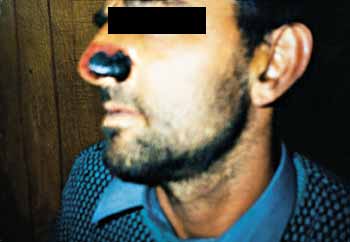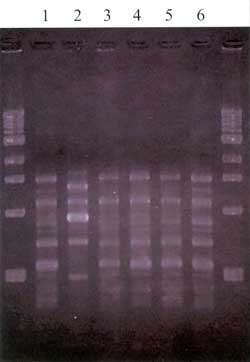| Anthrax in Southern Caucasus |
|
P.
Imnadze 1,
L. Bakanidze 1, M. Manrikyan 2, T. Kukhalashvili 1, E. Zangaladze
1, M. Kekelidze 1, D. Tsereteli 1, M. Nadiradze 1, Sh. Tsanava 1,
N. Tsertsvadze 1 |
| Key-words: Anthrax, B. anthracis, AP-PCR |
|
During the last 13 years in countries of Southern Caucasus 35 strains of B. anthracis were isolated (among them 17 from humans, others from beef, cattle skin, animal hair and soil). Isolated strains are of high virulence. AP-PCR identified a relationship among the tested isolates. The genetic profiles of 23 B. anthracis strains were identical to each other. One strain isolated in 1989 from the burial site has a distinguished genetic profile. |
Schlüsselwörter: Anthrax, Bacillus anthracis, AP-PCR |
|
In den letzten 13 Jahren wurde im südlichen
Kaukasus 25-mal Bacillus anthracis isoliert (in 17 Fällen
aus humanem Untersuchungsmaterial; |
| Introduction
Anthrax is an acute infectious disease, and its eradication or control is one of the main goals of Public Health and veterinary. Recent events in US, wide use of anthrax, as the agent of biological terrorism, increased the interest in this pathogen. Combating the infection, reducing potential sources of it, and carrying out timely measures is very important worldwide. Anthrax in Georgia is well known from the middle of the centuries. Even in 1697 the famous Georgian writer Sulkhan-Saba Orbeliani describes this disease as very acute and dangerous. During the 20th century increase in anthrax morbidity was seen in the years 1924-1925 and 1941-1945. |
| Materials
and Methods
Anthrax was diagnosed based on clinical, epidemiological and laboratory data. Laboratory investigation consists of microbiological methods [1]. Skin lesions, materials from cattle, environmental samples were tested. Main method for laboratory diagnostics of anthrax was microbiological (microscopy, seeding on media, bioprobes on laboratory animals), serological and allergic methods were used as well. B. anthracis was isolated by growth on beef-peptone agar and beef-peptone broth pH 7,2. After incubation in 37ºC for 24 hours typical for B. anthracis growth was seen both on solid and liquid media. B. anthracis was identified by a number of specific characteristics: morphology of microbial cells, character of growth in broth, mobility, hemolitic activity, coagulation of egg protein and pathogenicity for laboratory animals (white mouse). AP-PCR was performed using a RAPD Kit containing ready-to-go analysis beads („Amersham“). Primer # 5 of the kit (5-AAC GCG CAAC-3) was superior to the other primers examined. Therefore all subsequent AP-PCR was performed using this primer. Bacterial DNA for AP-PCR was derived by the standard methodology. AP-PCR was performed using the following cycle profile: 1 cycle at 95°C for 5 minutes, 45 cycles (95°C - 1 min, 36°C - 1 min, 72°C - 2 min), 1 cycle at 72°C for 5 min. |
| Results
and Discussion
In the last years a significant increase
in the number of anthrax cases was detected in the whole South Caucasus
region. During 1996-2001 in Georgia 153 cases of anthrax were registered,
in Armenia 41 cases. 64% of patients with anthrax are men, the disease
prevails in age groups 31-40 years (31%) and 41-50 years (26%).
Anthrax in Southern Caucasus is characterized by marred seasonal
prevalence – the end of spring and in early autumn register
92,6 per cent of the cases. The disease cases were registered in
cattle and humans as well as appearance of recently infected fields
has been observed. After 1989 only one patient was registered with
the intestinal form of the disease, all others had cutaneous form.
Two patients died (one of them had intestinal form). Incubation
period in 95% of cases lasted 2-4 days. In cutaneous form ulcers
were located predominantly on hands (97% of cases) (Fig. 1). In
one case the skin lesion was on the nose (Fig. 2). The main source
of infection with anthrax is infected live-stock (among them cattle
in 84,3%, small cattle 14,2%, horses 0,8% and pigs 0,7% of cases).
The disease cases were registered in cattle and humans as well as
appearance of recently infected fields has been observed [2]. In
2001 17 cases of anthrax were registered in humans in western Georgia.
During the same year in Armenia 18 human anthrax cases were registered.
All were cutaneous forms.
The main reason of infecting humans
and cattle with anthrax today is: 24 B. anthracis-strains were
tested in this study. Isolates were collected from different sources
during 1989-2001 and identified by the NCDC Anthrax Laboratory.
AP-PCR identified relationship among the tested isolates. The genetic
profiles for 23 B. anthracis-strains were identical to each
other. One strain (No. 2) isolated in 1989 from the burial site
has a different genetic profile (Fig. 3).
|
| References:
1. „Diagnostics of particularly Dangerous and Less Known Infections (Methods of Laboratory investigation).“ Rostov University Press, (1970) 193-214. 2. Turnbull P.C.B.: „Guidelines for the Surveillance and Control of Anthrax in Humans and Animals, WHO Department of Communicable Diseases Surveillance and response.“ (1998). |
| Corresponding
author: P. Imnadze, Ph.D., M.D., Director National Center for Disease Control 9, Asatiani St., Tbilisi, 380077, Georgia |


